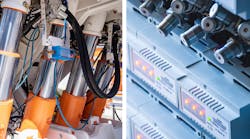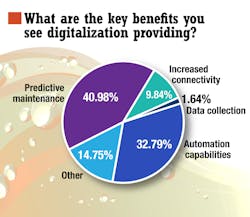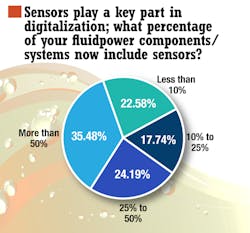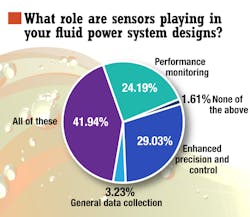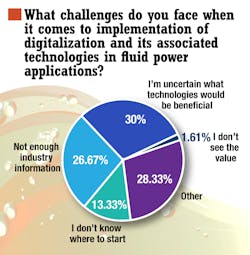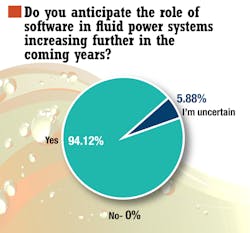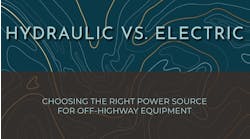Digitalization is making its way into a variety of industries. But what exactly is digitalization and how can it benefit hydraulics and pneumatics?
To get a sense of where the industry currently stands on the subject, Power & Motion surveyed its audience – looking at how much is understood about digitalization and to what extent it is being utilized in fluid power systems.
What is Digitalization?
A majority of respondents to the survey said they were either very familiar or somewhat familiar with the term digitalization, the technologies it entails and how it can be applied with the majority, 56.45% responding they were somewhat familiar.
An overwhelming majority, just over 95%, agreed that more education and information on the subject is needed within the fluid power industry.
So to aid with that, it may be important to start by defining digitalization. In a white paper from the National Fluid Power Association (NFPA) – released ahead of the International Fluid Power Exposition (IFPE) 2023 where digitalization was a key trend on display – the term is defined as leveraging digital technologies to enable or improve processes.
READ MORE: 3 Key Technology Trends at IFPE 2023
This can be achieved through use of on-board or centralized processing technologies which can help to collect, analyze and transmit information about the performance of a component or system. NFPA’s white paper points to Casappa’s Smart Piston Pump, displayed at IFPE 2023, as an example of digitalization in a fluid power application. The pump features an integrated electronic control unit (ECU) and sensors which help to provide enhanced digital control of the hydraulic pump, improving its efficiency.
It should also be noted the term digitalization is different from digitization. The latter refers to making analog information digital which can then enable digitalization. Essentially, digitization can be viewed as the ability to collect and send data and digitalization as use of that data to improve performance or other aspects.
Kevin Vanderslice, Director of Sales, Mobile Machinery at ifm efector inc., spoke at IFPE about the digital transformation currently taking place. A key aspect for OEMs, their suppliers and end users is understanding why digital technologies are important and why anyone should care about the data which can be collected. He said the digital revolution is happening and everyone is at different stages of implementation.
What Technologies are Involved?
Enabling digitalization is the increased integration of electronics, such as sensors, into components and systems. This allows the collection of performance data which can then be analyzed and transmitted.
The majority of survey respondents said their fluid power systems now include sensors, with just over 35% indicating more than 50% of the components and systems they are designing have sensors included. This was closely followed by 24% responding 25-50% of their fluid power components and systems feature integrated sensors.
However, almost 23% said less than 10% of their hydraulic and pneumatic systems include sensors, indicating there is still room for growth in this area.
Of those integrating sensors into their fluid power systems, the majority are using them for performance monitoring and enhancement of precision and control. Several respondents indicated sensors are being utilized for multiple purposes as well.
In an interview with Power & Motion, Russ Schneidewind, OEM Sales Manager at HydraForce, said the company is seeing the need for increased precision and control from hydraulic components. As such, HydraForce is among those integrating more sensors into its products. Its new Innercept Digital Proportional Control solution, for instance, features an integrated position sensor and Linear Variable Differential Transformer (LVDT) to improve upon the precision and control of its hydraulic components.
HydraForce has also partnered with Tan Delta and Elevāt to pair its hydraulic systems with an oil monitoring sensor and telematics. This will allow performance of the system to be better monitored and alerts sent to machine owners as needed if issues arise. Schneidewind sees incorporation of sensors and telematics increasing within the fluid power industry to help better monitor system performance.
As Vanderslice explained during ifm's press conference at IFPE, sensors provide the data and telematics will provide the knowledge to interpret that data.
To enable these performance monitoring capabilities, artificial intelligence (AI) and the Internet of Things (IoT) are often used to interpret collected data and transmit it to maintenance personnel. In some cases this information can be used to predict maintenance needs, helping machine owners improve their operations. Having the ability to better monitor when or if a maintenance issue will occur allows them to be proactive about maintenance needs and reduce the chances of costly unplanned downtime.
READ MORE: How to Implement AI in Fluid Power Applications
In conjunction with the rise of integrated sensors is the growing use of software which can work together with the sensors, AI and IoT to collect, analyze and transmit data. The majority of survey respondents said they have seen use of software increase in recent years and 94% anticipate its role in hydraulic and pneumatic systems increasing further in the coming years.
Challenges and Opportunities
While it is clear digitalization is making its way into the fluid power industry, responses to Power & Motion’s survey showed there is less clarity when it comes to implementing it.
About half of the respondents indicated the top challenges associated with implementing digitalization are a lack of industry information and uncertainty about what technologies would be beneficial. Additionally, some said the amount of software choices and tools for configuration and programming can pose challenges as well.
Multiple respondents noted a resistance to change within the industry and the need to convince management and customers of the benefits. Current approaches not being up to date, the age of equipment, the amount of time needed to implement technologies and costs associated with doing so were also offered as challenges for the industry.
In general though, the majority of respondents see digitalization benefiting the fluid power industry with almost 97% indicating as such. Predictive maintenance was the top choice among the potential benefits of digitalization in hydraulic and pneumatic systems. This was followed closely by the ability to integrate automation into systems.
Energy efficiency, improved performance, failure monitoring and cost savings – likely through the ability to improve maintenance and performance – were also benefits which respondents said could be achieved through the implementation of digitalization.
The overwhelming majority – 98% of survey respondents – foresee further growth of digitalization and its associated technologies in the fluid power industry over the coming years.
